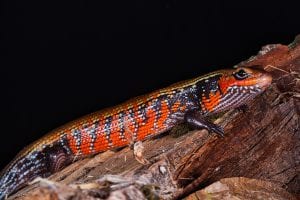A very impressive lizard species, bright and colourful, the Fire skink inhabits tropical forests in Western Africa. Total length is around 40cm, snout to vet around 20-23cm – but it is their colouration that impresses the most.
This species was brought in to the UK hobby originally as wild caught adults. They have not proven to be an easy species to breed, however they are quite an easy species to track down as CB as more breeders produce them. WC are still brought in, but in dramatically reduced numbers, this could cause future issues with inbreeding – WC stock is still important.
They are a relatively easy species to care for, and they tame down from their naturally fast and skittish nature in very little time at all. They come from tropical rainforests and it is necessary this is understood, especially if breeding is to be attempted. They are opportunists climbers, but mainly fossorial and a burrowing species (like many skink species).
Provide them with a three to four feet long vivarium as a minimum size – height should be around 2 feet. Provide a relatively deep substrate of around 6 inches in depth – a moisture retaining substrate such as orchid bark, Arcadia Earth Mix and leaf litter is ideal. Flat hides placed on the top of the substrate provides natural areas for them to burrow into the substrate, finding differing levels of moisture as they dig. A small water bowl, branches to climb when they feel inclined and perhaps some uprights such as cork bark will provide further climbing and hide opportunities. Plants can be provided, their burrowing activities usually mean they kill many plants, so artificial maybe a sensible option.
 Heating is best provided by an over head heat source, there are personal preferences involved – some keepers are venomously against one type over another. Halogen, ceramic and incandescent bulbs are all utilised by keepers, our own preference is ceramic heaters to allow total control independently of heat and light. Lighting is best provided by T5 fluorescent tubes, a 6{cb5d0a8cf0c44aef2db327d9ab0dba08dd09aed1126b509e5fa01d3aaa87fe47} if mounted reasonably close, or a 10-12{cb5d0a8cf0c44aef2db327d9ab0dba08dd09aed1126b509e5fa01d3aaa87fe47} if mounted some distance away is ideal. Temperatures should be around 28-30C in the warm end, as a further note I like to provide something that absorbs heat under the overhead heater to provide belly heat too.
Heating is best provided by an over head heat source, there are personal preferences involved – some keepers are venomously against one type over another. Halogen, ceramic and incandescent bulbs are all utilised by keepers, our own preference is ceramic heaters to allow total control independently of heat and light. Lighting is best provided by T5 fluorescent tubes, a 6{cb5d0a8cf0c44aef2db327d9ab0dba08dd09aed1126b509e5fa01d3aaa87fe47} if mounted reasonably close, or a 10-12{cb5d0a8cf0c44aef2db327d9ab0dba08dd09aed1126b509e5fa01d3aaa87fe47} if mounted some distance away is ideal. Temperatures should be around 28-30C in the warm end, as a further note I like to provide something that absorbs heat under the overhead heater to provide belly heat too.
Food is the usual affair for many lizards, a wide variety of gut loaded and supplemented insects – some will take an occasional pink mouse, and I have seen some eat ripe fruit too.
Breeding is possible in captivity if the correct conditions and diet are provided. They are oviparous and lay around five to nine eggs that take around 45 to 60 days to hatch, depending on temperature.
